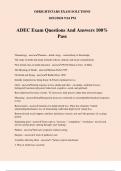©BRIGHTSTARS EXAM SOLUTIONS
10/21/2024 9:24 PM
ADEC Exam Questions And Answers 100%
Pass
Thanatology - answer✔Thanatos - death; ology - science/body of knowledge
The study of death and dying. Includes ethical, cultural, and moral considerations
First formal class in death education - answer✔1963 R Fulton at Univ. of Minn
The Meaning of Death - answer✔Herman Fiefel 1959
On Death and Dying - answer✔E Kubler-Ross 1969
Initially interpreted as being linear. K-R later explained not so.
Grief - answer✔Normal response to loss (death and other - secondary, nonfinite losses);
feelings/all reactions (physical, behavioral, cognitive, social, and spiritual)
Best understood in terms of tasks, "R" processes, dual process rather than universal stages.
Mourning - answer✔Intra/Interpsychic processes restricted to societal/public/ritualized responses
to loss
Bereavement - answer✔situation of a death related loss. Three key elements: Valued
relationship/attachment, loss of relationship, individual deprived of valued loss.
Bereaved need social support, nutrition, hydration, exercise, rest and *the presence of a caring
person.
Explaining grief - answer✔Terms such as "recovery," "completion," "resolution," not favored.
also be careful about "getting through" and "healing."
Palliate - answer✔Alleviate symptoms without curing
Hospice - answer✔A form of palliative care
Variables affecting Grief - answer✔1. Nature of prior attachment
2. Way in which loss occurred
, ©BRIGHTSTARS EXAM SOLUTIONS
10/21/2024 9:24 PM
3. Coping strategies
4. Developmental level/situation of bereaved
5. Nature of support available
DSM 5 - answer✔Grief - emptiness, loss; depression- nonspecific, inability to experience
pleasure, self loathing
Needs of Bereaved - answer✔Cognitive tasks - Need for information
Affective - Express emotions
Behavioral - Mark event with external actions
Valuation - Make sense of loss
Grief Counseling - answer✔Counseling directed at those experiencing normal, uncomplicated
grief. Grief therapy for more significant problems.
Death Notice - answer✔Brief standardized printed statement
Coroner - answer✔Elected official, pronounces death, determines if autopsy necessary
Mortician - answer✔Works at funeral home, embalms, organizes funeral arrangements
Medical Examiner - answer✔Doctor with degree in forensic pathology
Why Bereavement Intervention - answer✔Bereavement related response and difficulties.
Two track model:
1. Biophysical
2. Ongoing relationship w/deceased
Bereavement Support Groups - answer✔Provide identification, universality, catharsis, guidance,
instill hope, existential issues, cohesiveness, altruism
Techniques include: Cognitive restructuring, letter writing, use of metaphors
Death Education - answer✔Focusing on human/emotional aspects of death and dying.
In 1970s, explosion of scholarly articles. In 80s, more attention toward death anxiety.
Formal or informal.
Four aspects: Cognitive, Affective, Behavioral, Valuation
, ©BRIGHTSTARS EXAM SOLUTIONS
10/21/2024 9:24 PM
Goals: Enrich personal lives, Inform & guide, Prepare for public/professional roles (euthanasia,
organ/tissue donation), Enhance communication regarding death related matters, Appreciate how
life span interacts with death.
Causes of Death - answer✔In US, about 75% die in institution, Women 81, Men 76.
N - natural (cardiovascular, cancer, cerebrovascular, respiratory)
A - accident
S - suicide
H - homicide
Complicated Grief - answer✔Intense longing/searching, intrusive thoughts, purposelessness,
detachment. Failure to accept loss, prolonged grief disorder, period of more than six months.
Legal Cases - answer✔Quinlan - NJ - Surrogate able to decide about end of life
Cruzan - Missouri - State rights "clear and convincing" evidence
Schiavo - Florida - remove feeding tube - husband vs. family
Pathological Grief - answer✔Threat to health/well being of person.
Inhibited grief/delayed grief chronic-defining elements
PTSD - answer✔Stressor Event, Re-experiencing of Symptoms, Avoidance Behavior(s),
Numbing of General Responsiveness, Arousal.
Tasks of Death - answer✔Allows for more variance in grief experience. Tasks are work, can
address then leave for later. Dying are actors not reactors.
ADEC - answer✔Association for Death Education and Counseling
Originally "Forum for Death Education," established in 1976.
Thomas Attig (2000. 2010) - answer✔Relearn world via finding/making meaning, transition
from "loving in presence to loving in absence." Reaching through hurt, how person lives in our
lives - dancing in separation. "First encounters" - being stimulated by food, music, places. One
grieves individually, as family, as community.
Philipe Aries - answer✔(1974, 1981, 1985) French cultural historian. Noted five dominant
historical patterns related to death:
1. Tame death - calming awaiting, social event, death not feared, sleep/eternal bliss




